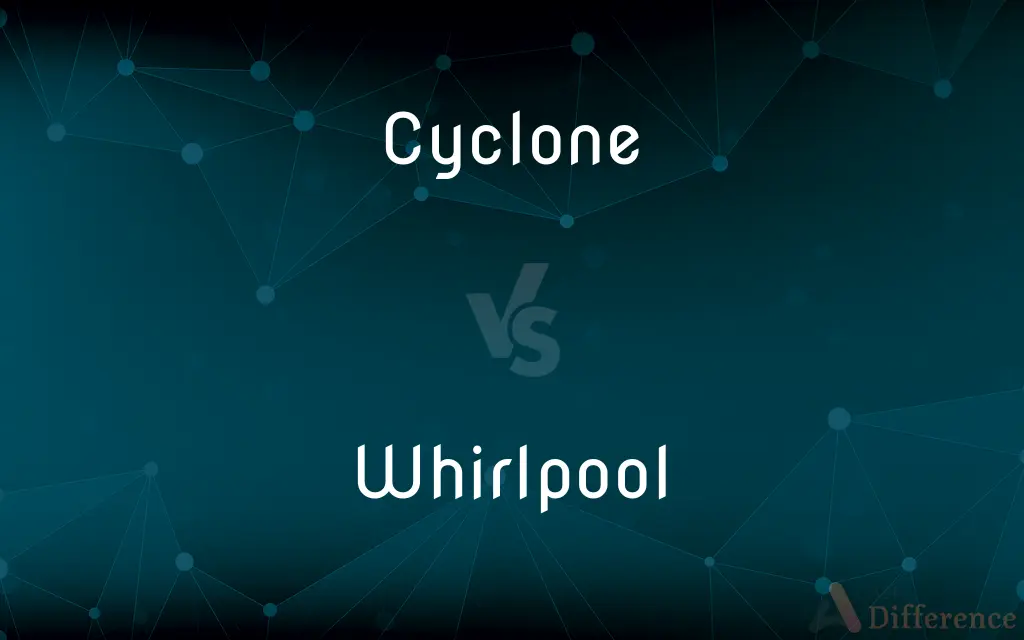Cyclone vs. Whirlpool — What's the Difference?
By Urooj Arif & Fiza Rafique — Updated on March 28, 2024
A cyclone is a large scale air mass that rotates around a strong center of low atmospheric pressure, while a whirlpool is a water body phenomenon where water spins around a center point, often caused by conflicting currents.

Difference Between Cyclone and Whirlpool
Table of Contents
ADVERTISEMENT
Key Differences
Cyclones form in the atmosphere due to variations in air temperature, creating low pressure areas around which air masses rotate, often bringing severe weather. On the other hand, whirlpools occur in bodies of water when opposing currents meet or water is rapidly drained, creating a vortex.
Cyclones can span thousands of kilometers and affect vast regions with strong winds, heavy rain, and storms. Whirlpools, however, are relatively smaller in scale, affecting localized areas in rivers, oceans, or man-made structures like drains.
The formation of a cyclone is influenced by geographical and atmospheric conditions, such as temperature gradients and humidity levels. In contrast, whirlpools are formed by water flow dynamics, including the shape of the water body and obstacles that disrupt the flow.
Cyclones are classified into types, such as tropical, subtropical, and extratropical, based on their formation region and characteristics. Whereas, whirlpools are often distinguished by their size and the strength of their vortex, from small eddies to powerful maelstroms.
While cyclones can cause widespread destruction through flooding, wind damage, and storm surges, whirlpools pose significant risks mainly to swimmers, boats, and marine life caught in their powerful currents.
ADVERTISEMENT
Comparison Chart
Definition
A rotating air mass around a low-pressure center.
A rotating water body caused by conflicting currents.
Scale
Thousands of kilometers.
Can range from small eddies to large maelstroms.
Formation Conditions
Atmospheric conditions like temperature gradients.
Water flow dynamics and geographical features.
Types/Classifications
Tropical, Subtropical, Extratropical.
Classified by size and strength of the vortex.
Main Hazards
Wind damage, heavy rain, storms.
Risks to swimmers, boats, marine life.
Compare with Definitions
Cyclone
Can lead to natural disasters like hurricanes or typhoons.
The cyclone intensified into a category 4 hurricane.
Whirlpool
Often seen near waterfalls or where water is drained.
A whirlpool formed as the lake drained through the narrow channel.
Cyclone
Often characterized by heavy rains and thunderstorms.
The approaching cyclone prompted evacuations.
Whirlpool
Can occur in natural or man-made water bodies.
The whirlpool near the river bend is a known hazard.
Cyclone
Predicted through meteorological observations.
Meteorologists issued warnings for the incoming cyclone.
Whirlpool
Varies in size from small swirls to large maelstroms.
Legend speaks of a giant whirlpool swallowing entire ships.
Cyclone
Affects large geographical areas and can last for days.
The cyclone disrupted power supplies across the region.
Whirlpool
Poses dangers to swimmers and small vessels.
Swimmers are advised to avoid the area due to whirlpools.
Cyclone
A system of winds rotating inward to an area of low atmospheric pressure.
The cyclone caused widespread flooding.
Whirlpool
A body of swirling water formed by the meeting of opposing currents.
The boat struggled against the powerful whirlpool.
Cyclone
In meteorology, a cyclone () is a large scale air mass that rotates around a strong center of low atmospheric pressure, counterclockwise in the Northern Hemisphere and clockwise in the Southern Hemisphere as viewed from above (opposite to an anticyclone). Cyclones are characterized by inward-spiraling winds that rotate about a zone of low pressure.
Whirlpool
A whirlpool is a body of rotating water produced by opposing currents or a current running into an obstacle. Small whirlpools form when a bath or a sink is draining.
Cyclone
A system of winds rotating inwards to an area of low barometric pressure, with an anticlockwise (northern hemisphere) or clockwise (southern hemisphere) circulation; a depression.
Whirlpool
A rapidly rotating current of water; a vortex.
Cyclone
An atmospheric system characterized by the rapid inward circulation of air masses about a low-pressure center, usually accompanied by stormy, often destructive weather. Cyclones circulate counterclockwise in the Northern Hemisphere and clockwise in the Southern Hemisphere.
Whirlpool
Something, such as a situation, that is confusing or tumultuous and is easy to be drawn into or difficult to get out of
Was sucked into a whirlpool of despair.
Cyclone
A violent tropical storm, especially one originating in the southwestern Pacific Ocean or Indian Ocean.
Whirlpool
A bathtub or pool having jets of warm water that can be directed toward a body part as for therapeutic purposes.
Cyclone
A violent rotating windstorm, especially a tornado.
Whirlpool
A swirling body of water.
A whirlpool is an instance of a vortex produced by ocean tides, or by a hole underneath where the water would drain out, such as in a bathtub.
Cyclone
Any of various devices using centrifugal force to separate materials.
Whirlpool
A hot tub, jacuzzi.
Cyclone
(broad sense) A weather phenomenon consisting of a system of winds rotating around a center of low atmospheric pressure
Whirlpool
Turmoil, or agitated excitement.
Cyclone
(narrow sense) Such weather phenomenon occurring in the South Pacific and Indian Ocean
Whirlpool
(intransitive) To spin or swirl like the water in a whirlpool.
Cyclone
A low pressure system.
Whirlpool
An eddy or vortex of water; a place in a body of water where the water moves round in a circle so as to produce a depression or cavity in the center, into which floating objects may be drawn; any body of water having a more or less circular motion caused by its flowing in an irregular channel, by the coming together of opposing currents, or the like.
Cyclone
(informal) The more or less violent, small-scale circulations such as tornadoes, waterspouts, and dust devils.
Whirlpool
A sea monster of the whale kind.
The Indian Sea breedeth the most and the biggest fishes that are; among which the whales and whirlpools, called "balænæ," take up in length as much as four . . . arpents of land.
Cyclone
A strong wind.
Whirlpool
A powerful circular current of water (usually the resulting of conflicting tides)
Cyclone
A cyclone separator; the cylindrical vortex tube within such a separator
Whirlpool
Flow in a circular current, of liquids
Cyclone
To separate using a cyclone separator.
Cyclone
To storm as a cyclone.
Cyclone
To whirl in spirals as a result of a cyclone or whirlwind-like force.
Cyclone
To storm wildly; to be in a frenzy.
Cyclone
A violent storm, often of vast extent, characterized by high winds rotating about a calm center of low atmospheric pressure. This center moves onward, often with a velocity of twenty or thirty miles an hour.
Cyclone
In general, a condition of the atmosphere characterized by a central area of pressure much lower than that of surrounding areas, and a system of winds blowing inward and around (clockwise in the southern hemisphere and counter-clockwise in the northern); - called also a low-area storm. It is attended by high temperature, moist air, abundant precipitation, and clouded sky. The term includes the hurricane, typhoon, and tropical storms; it should not be applied to the moderate disturbances attending ordinary areas of low pressure nor to tornadoes, waterspouts, or "twisters," in which the vertical motion is more important than the horizontal.
Cyclone
A tornado. See above, and Tornado.
Cyclone
(meteorology) rapid inward circulation of air masses about a low-pressure center; circling counterclockwise in the northern hemisphere and clockwise in the southern
Cyclone
A violent rotating windstorm
Common Curiosities
Can cyclones affect inland areas?
Yes, cyclones can move inland, bringing heavy rainfall and wind, but they usually weaken without the energy provided by warm ocean waters.
What causes a cyclone?
A cyclone is caused by a combination of atmospheric conditions, including low-pressure centers, warm temperatures, and moisture in the air.
What's the difference between a hurricane and a cyclone?
The terms hurricane and cyclone refer to the same phenomenon but are used in different regions; hurricanes are in the Atlantic and Northeast Pacific, while cyclones occur in the South Pacific and Indian Ocean.
How long can a cyclone last?
Cyclones can last from several days to over a week, depending on conditions such as sea surface temperature and atmospheric stability.
How do whirlpools form?
Whirlpools form when opposing water currents meet or water flows through a narrow pathway, creating a spinning motion.
Can whirlpools form in any body of water?
Whirlpools can form in any body of water where there is sufficient movement and conditions for a vortex to develop, including rivers, lakes, and oceans.
How are cyclones named?
Cyclones are named from a pre-determined list to simplify communications and avoid confusion during disaster responses.
Are whirlpools always dangerous?
The danger of a whirlpool varies with its size and current strength; small whirlpools are generally harmless, while large ones can be very dangerous.
Can whirlpools appear in swimming pools?
Small whirlpools can form in swimming pools due to water circulation systems, but they are usually too weak to pose a danger.
What technologies are used to predict cyclones?
Satellite imagery, weather radars, and computer models are crucial for predicting the formation and path of cyclones.
How can one survive a whirlpool encounter?
To survive a whirlpool, it's advised to swim parallel to the vortex's edge or float to conserve energy until the current weakens.
Are there any beneficial effects of cyclones?
Cyclones can bring needed rain to drought-prone areas and help balance heat distribution across the Earth.
What measures can be taken to mitigate cyclone damage?
Building resilient infrastructure, early warning systems, and community preparedness plans are key measures to mitigate the impact of cyclones.
What is the largest whirlpool in the world?
The largest whirlpools, such as the Maelstrom off Norway, are renowned for their size and the legends surrounding them.
How do cyclones affect marine life?
Cyclones can disrupt marine ecosystems, damage coral reefs, and lead to fish mortality due to changes in water temperature and salinity.
Share Your Discovery

Previous Comparison
Privacy vs. Secrecy
Next Comparison
Insect vs. AmphibianAuthor Spotlight
Written by
Urooj ArifUrooj is a skilled content writer at Ask Difference, known for her exceptional ability to simplify complex topics into engaging and informative content. With a passion for research and a flair for clear, concise writing, she consistently delivers articles that resonate with our diverse audience.
Co-written by
Fiza RafiqueFiza Rafique is a skilled content writer at AskDifference.com, where she meticulously refines and enhances written pieces. Drawing from her vast editorial expertise, Fiza ensures clarity, accuracy, and precision in every article. Passionate about language, she continually seeks to elevate the quality of content for readers worldwide.
















































